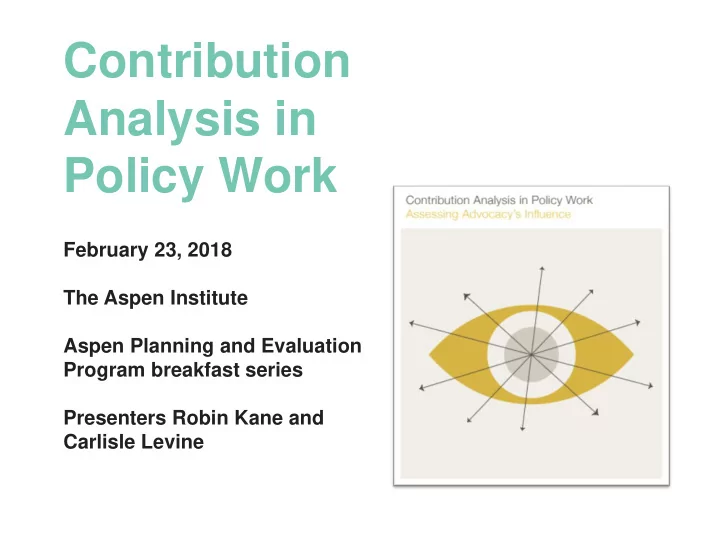

Contribution Analysis in Policy Work February 23, 2018 The Aspen Institute Aspen Planning and Evaluation Program breakfast series Presenters Robin Kane and Carlisle Levine
Today’s objectives ❖ Introduce Contribution Analysis in Policy Work ❖ Provide an overview of the approach ❖ Offer case examples ❖ Describe some benefits and challenges ❖ Answer questions and discuss other contribution analysis experiences and resources
Purpose of the brief ❖ Assist funders and evaluators to decide if contribution analysis is a good choice ❖ Provide a step-by-step guide for applying the process in an advocacy evaluation context ❖ Share case studies about how we applied it, and what we learned
Contribution analysis ❖ Theory-based approach to causal analysis that acknowledges that many factors influence a given outcome ❖ A six-step process to test a theory against logic and evidence to reduce uncertainty about the contribution of an initiative to observed results
Contribution analysis steps
Step 1 Set out the cause-effect issue to be addressed. ❖ Partner with stakeholders to determine the cause-effect issue to address. ❖ Select an issue that is specific and time bound.
Three causal problems for PPD-6 1. To what extent and how did MFAN contribute to the issuance of PPD-6? 2. To what extent and how did MFAN contribute to the content of PPD-6? 3. To what extent and how did MFAN contribute to the key changes that flowed from the directive?
Step 2 Develop the theory of change and the risks to it, including alternative explanations. ❖ Make explicit the theory of change. ❖ Identify causal assumptions to test. ❖ Determine other factors that may have influenced the policy outcome.
Step 3 Gather the existing evidence on the theory of change. ❖ Formulate hypotheses about linkages and assumptions in the results chain. ❖ Clarify evidence that can substantiate or disconfirm the linkages, and identify other potential influencing factors. ❖ Gather evidence to test your claims, first from those closest to the advocacy initiative.
Step 4 Assemble and assess the contribution claim, and challenges to it. ❖ Provide a narrative description of the outcome of interest and the emerging consensus view about the contribution claim. ❖ Account for influencing factors and key alternative explanations. ❖ Identify where evidence is lacking to assess the strength of the contribution claim.
Step 5 Seek out additional evidence. ❖ Determine which linkages and alternative explanations are critical to the story and require additional evidence. ❖ Seek interviews with policymakers or other policy targets, when feasible. ❖ Assess the danger or harm interviews might create for the advocacy process.
Step 6 Revise and strengthen the contribution story. ❖ Revise the contribution story, based on additional data collected. ❖ Present evidence for and against the causal claim. ❖ Eliminate extraneous details that are no longer relevant to the story to make it more logically persuasive.
Step 7 Use the contribution stories to review, learn, and improve the initiative. ❖ Provide opportunities for those involved to think about how their contributions add value, and what else they might do. ❖ Build capacity for collaboration and influence. ❖ Use findings to inform future planning.
Benefits ❖ Philosophically aligned with how policy evaluators generally approach their work ❖ Provides a systematic approach to think critically about how advocates, allies, opponents, and policymakers influence each other’s actions in a complex multi -actor environment ❖ Seeks alternative explanations for policy outcomes to add credibility to the story, and avoid confirmation bias
Challenges ❖ Takes time to create and test a contribution story ❖ Requires access to advocates and policymakers ❖ Diplomacy is essential!
Questions? Thoughts about using contribution analysis?
Where You Can Find the Brief ❖ Center for Evaluation Innovation ❖ BLE Solutions ❖ ORS Impact ❖ RK Evaluation & Strategies
Thank you! Contact us: Robin Kane robin@rkevaluation.com Carlisle Levine carlisle.levine@blesolutions.com Carlyn Orians corians@orsimpact.com Claire Reinelt reinelt.claire@gmail.com
Recommend
More recommend